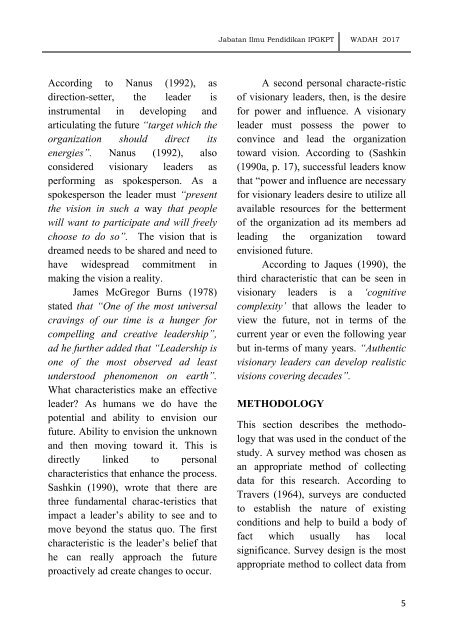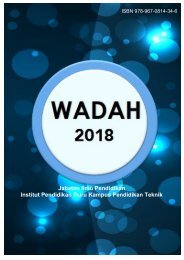WADAH 2017_FINAL
You also want an ePaper? Increase the reach of your titles
YUMPU automatically turns print PDFs into web optimized ePapers that Google loves.
Jabatan Ilmu Pendidikan IPGKPT <strong>WADAH</strong> <strong>2017</strong><br />
According to Nanus (1992), as<br />
direction-setter, the leader is<br />
instrumental in developing and<br />
articulating the future “target which the<br />
organization should direct its<br />
energies”. Nanus (1992), also<br />
considered visionary leaders as<br />
performing as spokesperson. As a<br />
spokesperson the leader must “present<br />
the vision in such a way that people<br />
will want to participate and will freely<br />
choose to do so”. The vision that is<br />
dreamed needs to be shared and need to<br />
have widespread commitment in<br />
making the vision a reality.<br />
James McGregor Burns (1978)<br />
stated that “One of the most universal<br />
cravings of our time is a hunger for<br />
compelling and creative leadership”,<br />
ad he further added that “Leadership is<br />
one of the most observed ad least<br />
understood phenomenon on earth”.<br />
What characteristics make an effective<br />
leader? As humans we do have the<br />
potential and ability to envision our<br />
future. Ability to envision the unknown<br />
and then moving toward it. This is<br />
directly linked to personal<br />
characteristics that enhance the process.<br />
Sashkin (1990), wrote that there are<br />
three fundamental charac-teristics that<br />
impact a leader’s ability to see and to<br />
move beyond the status quo. The first<br />
characteristic is the leader’s belief that<br />
he can really approach the future<br />
proactively ad create changes to occur.<br />
A second personal characte-ristic<br />
of visionary leaders, then, is the desire<br />
for power and influence. A visionary<br />
leader must possess the power to<br />
convince and lead the organization<br />
toward vision. According to (Sashkin<br />
(1990a, p. 17), successful leaders know<br />
that “power and influence are necessary<br />
for visionary leaders desire to utilize all<br />
available resources for the betterment<br />
of the organization ad its members ad<br />
leading the organization toward<br />
envisioned future.<br />
According to Jaques (1990), the<br />
third characteristic that can be seen in<br />
visionary leaders is a ‘cognitive<br />
complexity’ that allows the leader to<br />
view the future, not in terms of the<br />
current year or even the following year<br />
but in-terms of many years. “Authentic<br />
visionary leaders can develop realistic<br />
visions covering decades”.<br />
METHODOLOGY<br />
This section describes the methodology<br />
that was used in the conduct of the<br />
study. A survey method was chosen as<br />
an appropriate method of collecting<br />
data for this research. According to<br />
Travers (1964), surveys are conducted<br />
to establish the nature of existing<br />
conditions and help to build a body of<br />
fact which usually has local<br />
significance. Survey design is the most<br />
appropriate method to collect data from<br />
5





